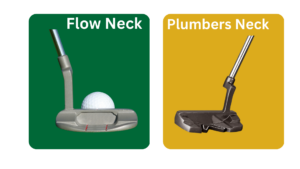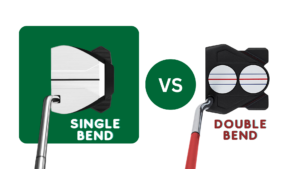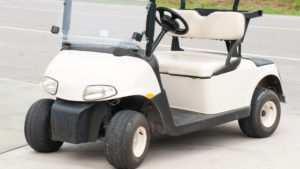Are you a golfer who is trying to decide between face balanced and toe hang putters? Comparing face balanced and toe hang putters can help you make an informed decision about which type is best for your game. Face balanced vs toe hang putter – which one should you choose for maximum performance on the course?
To help you make the best decision for your game, we’ll explore both face balanced and toe hang putters to provide an understanding of their differences. We’ll also provide some tips on maintaining your new club and getting the most out of it during each round.

Table of Contents:
- Face Balanced Putters
- Toe Hang Putters
- Benefits:
- Drawbacks:
- Comparison of Face Balanced and Toe Hang Putters
- Accuracy and Distance Control:
- Feel and Feedback on Impact:
- Player level:
- Choosing the Right Putter for You
- Maintenance Tips for Your Putter
- FAQs in Relation to Face Balanced vs Toe Hang Putter
- Conclusion
Face Balanced Putters
Face balanced putters are designed to help golfers achieve a more consistent and accurate putting stroke. The clubface of these putters is perfectly perpendicular to the ground, allowing for an even weight distribution across the face. This helps create a square strike on the ball, which leads to improved accuracy and distance control.

Benefits:
- One of the biggest benefits of using a face balanced putter is its ability to provide consistent results from shot-to-shot.
- With this type of club, you don’t have to worry about compensating for any imperfections in your stroke or adjusting your putter grip during different shots; it will stay true no matter what kind of swing you take at it.
- Because they’re so well-balanced, they tend to be very forgiving when hit off center — meaning that even if you don’t make perfect contact with every shot, you won’t suffer too much in terms of accuracy or distance control.
Drawbacks:
While face balanced putters can certainly improve your game overall, there are some drawbacks associated with them as well.
- They require more precision than other types of clubs – since they rely on such an even weight distribution across their faces – so if your swing isn’t quite up to par yet then this might not be the best option for you right now.
- Some players find that these clubs lack feel and feedback compared to toe hang models; while this isn’t necessarily a deal breaker for everyone (especially those who prioritize accuracy over feel), it’s something worth considering before making a purchase decision.
Face balanced putters offer a great way to improve accuracy and consistency in your putting stroke, however it is important to understand the differences between face balanced and toe hang putters before making a purchase. Toe hang putters can provide more power when hitting longer shots but come with their own unique set of benefits and drawbacks that should be considered.
Toe Hang Putters
A toe hang putter is a type of golf club that has a curved shaft and an offset putter head. This design helps to ensure the golfer’s hands are in the correct position at impact, resulting in more consistent contact with the ball. Toe hang putters have become increasingly popular among professional golfers and amateur players alike due to their ability to help improve accuracy on short putts.

Benefits:
- One of the biggest advantages of using a toe hang putter is its ability to provide better control over distance and direction when putting.
- The shape of the putter shaft helps keep your hands in proper alignment throughout your stroke, allowing you to hit consistently straight shots from any distance.
- Many toe hang models feature adjustable weights or counterbalance technology that can be used to customize feel for each individual player’s preferences.
- They’re designed for improved accuracy, these clubs can help lower scores by making it easier for golfers to sink those tricky short-range putts.
Drawbacks:
While there are certainly benefits associated with using a toe hang putter, there are also some potential drawbacks as well.
- These clubs tend to be heavier than other types of flatsticks so they may not suit all players’ needs or styles depending on their strength level or swing speed preference.
- Since they rely heavily on proper hand placement during the stroke process, it may require additional practice time before becoming comfortable enough with them for competitive play or tournament use.
Toe hang putters offer golfers a unique combination of benefits and drawbacks that can be beneficial depending on the golfer’s individual needs. However, in order to determine which type is best suited for each player, it is important to compare face balanced and toe hang putters side by side.
Comparison of Face Balanced and Toe Hang Putters

Accuracy and Distance Control:
Face balanced putters are generally more accurate and provide better distance control than toe hang putters. This is because the face of a face balanced putter remains square to the target line throughout the stroke, allowing for consistent contact with the ball.
On the other hand, toe hang putters have an arc-like motion which can cause inconsistency in contact with the ball. This can lead to inaccurate shots that may travel shorter or longer distances than intended. So if you are comfortable on pull putts then you should use more toe hang.
Feel and Feedback on Impact:
The feel and feedback from a face balanced putter tends to be softer than that of a toe hang model due to its low center of gravity design. As such, it provides golfers with good feedback when making contact with the ball without being overly harsh or jarring.
Toe hang models tend to have higher centers of gravity which result in less feel at impact as well as more vibration traveling up through your hands into your arms after striking the ball.
Player level:
Experimentation is key for golfers to determine which type of putter works best with their particular putting stroke mechanics and preferences. Beginners should generally opt for a face balanced putter while experienced players may find greater success using a toe hang model depending on their putting stroke mechanics and preferences.
For instance, those who use an arcing stroke will likely benefit from having more weight towards the heel (toe hang) whereas straight back/straight through strokes work best with even weight distribution around all points (face balance).
The comparison of face balanced and toe hang putters has shown that there are both advantages and disadvantages to each type, so it is important for golfers to choose the right one for their individual needs. Picking the optimal putter can be a tricky undertaking, yet with suitable research and experimentation you may locate the ideal fit for your play.
Choosing the Right Putter for You

When it comes to choosing the right putter for you, analyzing your putting stroke and goals is key. Besides, you should consider on some factors like putter length, grip shape, grip size, weight, loft, swing, etc. Every golfer has different needs when it comes to their equipment, so take some time to evaluate what kind of results you’re looking for from a putter. Are you trying to make more long-distance shots? Or are you working on improving accuracy around the green? Figuring out what kind of outcome you desire from your putter will assist in narrowing down the selections.
- Testing out different putters in person or online can also be helpful in finding the right fit for your game. When testing a club in person, pay attention to how it feels when striking a golf ball—is there good feedback through the shaft? Is there enough weight behind each shot? If possible, compare multiple models side by side and note any differences between them. Online reviews can also provide valuable insight into which clubs have been successful for other golfers with similar swings and playing styles as yours.
- Another way to make sure you get the ideal club for your game is to consult an expert. A knowledgeable pro shop attendant or instructor should be able to provide advice based on their experience fitting other players with similar characteristics as yourself—including age, height, strength level, and swing speed—to help guide you toward a club that best suits your needs. Don’t hesitate to ask questions about materials used in construction or design features that could affect performance before making a purchase decision.
Choosing the right putter takes research and patience; however, having one perfectly suited to your individual style can really improve consistency on the greens over time.
Finding the ideal putter for your golfing needs is key to enhancing your performance on the green, and with some research and experimentation, you can locate a perfect fit. To ensure that your putter remains in top condition, it’s important to maintain it regularly – read on for tips about cleaning, checking angles and replacing grips.
Maintenance Tips for Your Putter

Cleaning and polishing
Cleaning and polishing your putter regularly is an important part of maintaining it. This will help keep the clubhead in good condition, which can improve accuracy and distance control. Use a soft cloth to wipe away dirt and debris from the face of the clubhead after each use.
You should also use a specialized golf cleaner or mild soap solution to clean any stubborn dirt or grime that may have built up over time. Finally, you can use a light wax polish to protect the metal surface from rusting or corrosion.
Checking the loft, lie angle, and weight balance
Checking the loft, lie angle, and weight balance periodically helps ensure your putter performs as intended on every shot. Loft refers to how much backspin is generated when you strike the ball with your putter; if it’s too high or low then shots may go offline more often than desired.
Lie angle affects how well your hands remain square throughout impact; if it’s off then this could lead to mis-hits resulting in poor direction control.
Lastly, weight balance ensures optimal feel at impact; heavier heads provide better stability while lighter ones increase speed but reduce forgiveness on off-center hits.
Replacing grips
Replacing grips when necessary keeps them feeling comfortable during play so you can make consistent strokes with confidence every time you take aim at the hole. Over time, grips tend to wear out due to frequent usage and exposure to moisture, heat, and cold temperatures.
Signs of wear such as discoloration or fraying edges around where fingers rest on top of them for gripping purposes should be replaced once they start showing up.
There are several types available ranging from corded models for extra traction in wet conditions all the way up to synthetic leather options for those who prefer softer surfaces against their palms during swings.
FAQs in Relation to Face Balanced vs Toe Hang Putter
Should I use a face balanced or toe hang putter?
It depends on your personal preference and putting style. Face balanced putters are more stable, which makes them ideal for golfers who have a straight-back-straight-through stroke.
Toe hang putters tend to be better suited for players with an arc in their putting stroke because the weight is shifted towards the toe of the club, allowing it to rotate easier during your swing. Ultimately, choosing between face balanced or toe hang comes down to how comfortable you feel when using each type of putter.
Who should use a face balanced putter?
Face balanced putters are designed to help golfers achieve a more consistent putting stroke. This type of putter is ideal for players who have an arc-style putting stroke, as it helps keep the face square at impact and reduces skidding or bouncing off line.
Face balanced putters also offer better stability on short and long puts alike, making them great for both beginners and experienced golfers looking to improve their game.
Conclusion
To understand the differences between face balanced and toe hang putters before deciding which one is right for you. Face balanced putters are best suited for golfers with a straight-back stroke while toe hang putters work better for those who have a slight arc in their putting motion.
No matter what type of putter you choose, make sure that it fits your style and keep up with regular maintenance to ensure optimal performance on the course. With knowledge about face balanced vs toe hang putter styles, you can find the perfect fit for your game.
Discover the differences between face balanced and toe hang putters to help you decide which one is best for your game. Learn more about these types of putters, as well as helpful golfing tips, on GolfingEagle.com today!






